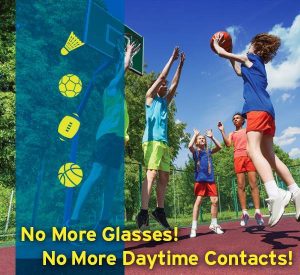Q1: What is myopia?
A: Myopia is a refractive error, or a vision condition that affects the ability to see distant images or objects clearly. Your eye doctor may refer to myopia as nearsightedness or shortsightedness.
According to the American Optometric Association, nearly 30 percent of the U.S. population, including both children and adults, suffer from myopia.
Q2: What are the signs and symptoms of myopia?
A: If your child is experiencing any of the following signs of myopia, schedule an eye exam with your eye doctor to determine if your child has a refractive error.
- Squinting when reading the board or watching TV
- Sitting at close proximity to the TV or computer screen
- Sitting at the front of the classroom to clearly see the teacher and board
- Holding books close to the eyes
- Disinterest in playing sports that require clear distance vision
- Reduced clarity of vision, as compared to friends and family
Q3: What causes myopia?
A: Myopia occurs when light enters the eye and focuses in front of the retina, rather than directly, on the retina. When the length of the eye is longer than normal, this particular shape causes the light to refract differently.
Myopia typically develops in childhood and worsens as the eyes continue to grow— as the eyes grow, so does their axial length. You may find that your child’s optical prescription worsens through their teenage years, and eventually reaches a plateau when the eye stops growing, typical around the age of 20.
Q4: Is myopia dangerous?
A: While myopia is not a dangerous vision condition, it does increase your child’s risk for developing serious, vision threatening eye diseases later in life.
In about 10 percent of people with myopia, the condition worsens in severity— and as myopia gets worse, your child’s risk of eye disease increases.
Eye diseases associated with high myopia include:
If your child has worsening myopia, contact an eye doctor near you who can discuss the eye health benefits of myopia management.
SEE RELATED: Myopia Management for Athletes
Q5: How can I prevent my child’s myopia from worsening?
A: Recent studies suggest that it may be possible to control myopia progression, before it gets worse— to protect children from high risks of eye diseases associated with high myopia.
Myopia management is a treatment program prescribed by eye doctors, to completely stop, or at least slow down myopia progression.
Many eye doctors believe that commonly prescribed single-vision glasses and contact lenses may actually contribute to myopia progression.
Studies show that although distance-only glasses and contact lenses improve distance vision clarity, they focus light onto the retina in a way that can actually increase the axial length of the eye. Therefore, myopia management techniques move away from single-vision lenses, and include different methods of myopia correction.
Q6: What is involved in myopia management?
A: Depending on the age and severity of your child’s myopia, your eye doctor may prescribe any of the following management techniques:
Eyeglasses
Eyeglasses are one of the most popular choices for younger children. For many children with myopia, a further diagnosis of reduced focusing skills, which make it difficult for their eyes to work together as a team, can cause myopia to progress and worsen.
For these children, corrective lenses that contain more than one optical prescription, such as a bifocal or multifocal, will be prescribed to support their focusing skills.
The optical power for near vision tasks reduces the stress on the eyes and the progression of myopia.
Bifocal lenses contain two optical powers. The top segment of the lens is used for distance vision, while the bottom segment is used for near-point tasks.
Multifocal lenses contain different lens powers throughout the lens, for distance, intermediate, and near vision tasks.
Contact lenses
Contact lenses are preferred by older children and adults with myopia, as they are more comfortable for sports and contribute to improved self-confidence in social gatherings. Contact lenses also provide a wider field of view as compared to eyeglasses.
Multifocal contact lenses are similar to multifocal eyeglasses, improving distance vision acuity while simultaneously reducing the stress on the eyes for reading and other near vision tasks.
Atropine eye drops
Studies show that a daily, low dose of these medicated eye drops can reduce myopia progression and prevent your child’s prescription from climbing higher and higher. This method is most effective for children between the ages of 8 and 15. While these drops can assist in slowing down myopia progression, they are not used to correct myopia— so your child will still need to wear their eyeglasses or contact lenses regularly.
Caution: Side effects of atropine eye drops may include blurry near vision or light sensitivity. Speak to your eye doctor if side effects are affecting your child’s daily routine.
Orthokeratology (Ortho-k)
Ortho-k has been proven to reduce the rate of myopia progression in children by up to 50 percent.
This method involves the use of specialized rigid contact lenses worn at night, while your child sleeps. These contact lenses flatten the cornea, the front outer surface of the eye, to improve the way light is focused onto the retina.
Ortho-k provides clear vision for the whole day, without the need for glasses or contacts.
Q7: How effective is myopia management?
A: Myopia management has shown to reduce myopia progression by up to 78 percent.
Q8: Can vision therapy control myopia progression?
A: Vision therapy is effective in treating reduced focusing skills that may be contributing to worsening myopia.
Vision therapy involves a personalized program aimed at training the visual system, including the eye-brain connection, to work more efficiently. By improving your child’s focusing skills, you are decreasing their risk of myopia progression.
Q9: When should my child start myopia management?
A: Myopia generally worsens through the teenage years, until it stabilizes as the child reaches adulthood. Therefore, for optimal results, it is best to begin myopia management in the teenage years or as soon as possible.
If your child has been diagnosed with myopia, or their myopia is getting worse each year, speak to your eye doctor about a myopia management plan.
Based on your child’s age and optical prescription, your eye doctor will determine which myopia management method will be most effective for your child.
LEARN MORE: Guide to Pediatric Eye Conditions
If your child has worsening myopia, contact an eye doctor near you who can discuss the eye health benefits of myopia management.


